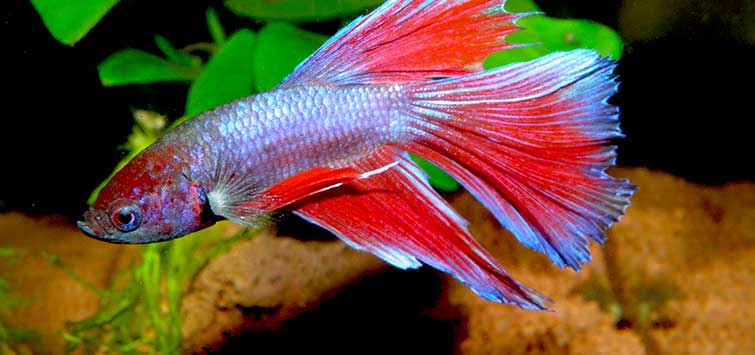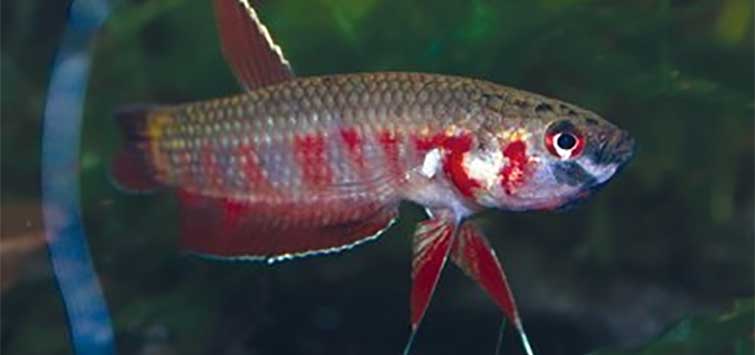Magnificent Bettas
Author: Stan Sung
With domesticated varieties available in every color of the rainbow and wild species as rare as they are beautiful, there is a betta out there to suit any aquarist’s taste.
Wide Variety of Bettas
The original betta in the hobby, Betta splendens, is available in an extreme variety of cultivated colors and fin types. In their native country of Thailand, they have been specifically bred for their fighting abilities. But that’s only the beginning. Aquarists looking for an exotic challenge may go for one of the other species in this genus, often called “wild bettas,” which offer a stunning variety and reproduce as either bubblenesters or mouthbrooders. As you will see from this assemblage of what some might consider the most beautiful fish of all, there really is a betta species or strain to delight any hobbyist.
Under the Pink Lotus
Both Betta splendens and Betta imbellismake their home in the swampy backwaters of Thailand and Malaysia. I have even scooped up scarlet and emerald B. splendens in the moat surrounding Angkor Wat in Cambodia. These are the betta species I most commonly encountered while doing field work in these regions. I have collected B. imbellis in anything from very soft, acidic peat swamps in western Malaysia to slightly brackish lakes on Thai islands in the Andaman Sea. In the blackwater habitats I found them living among submersed leaf litter along with fishes such as Systomus (Puntius) hexazona and Luciocephalus pulcher. Utilizing a handheld dipnet, these bettas can usually be found in water that is only several inches deep. The bubblenests on the surface of the water provide an easy way of locating breeding individuals, though the bubblenests often belong to Trichopsis vittata, a type of fish that seems to share most of its native habitats with the wild bettas.
Other anabantoids (fish that possess a labyrinth organ to breathe atmospheric air) living within these sometimes oxygen-deprived habitats are climbing perch Anabas testudineus, combtail gouramis Belontia hasselti, Betta pugnax, gouramis such as Trichogaster and Parosphronemus, and Channa snakeheads. There are also many wild betta species that have adapted remarkably well to fast-running streams. These elongated fish are mostly mouthbrooding types that are highly sought after by connoisseurs.
Extravagant Cultivars
With colorful and descriptive names such as copper/gold, dragon, blue and mustard gas, and crowntails and halfmoons, the selection is tremendous. Bettas have been bred in a dizzying array of spectacular colors. The black orchid is, like its name suggests, a classy, all-black fish. If a black fish is not your cup of tea, perhaps an opaque-white betta, in all of its creamy iridescence, is more suited to your tastes. Or maybe you’d prefer the breathtakingly beautiful copper-colored specimens. These days, line-bred Betta splendens literally do come in every color of the rainbow, plus various metallic colors. Besides the standard reds, purples, greens, and blues, these treasures of Siam are also found in exotic silvers, pewters, yellows, and oranges. Some of these colors have been obtained by hybridizing B. splendens with some of its congeners, notably B. imbellis.
Take any color within this palette and combine it with a white border, and you have the stunning butterfly bettas. Another distinct pattern is on the dragon bettas, which have luminescent, light-colored bodies and scales accentuated by a dark outline. The gas bettas are a sight to behold, as their fin coloration dissipates toward the outer edge of their fins, giving the illusion of dispersing gas or mist. Some varieties are heavily sprinkled with dark spots and slashes and are called marbled bettas.
Finnage
A variety of finnage types have also been selectively bred. The bettas with the shortest fins are known as plakats. These are most similar in shape to their wild cousins found in nature. Next in fin length are the halfmoons and crowntails. In the halfmoon the fins grow out to a moderate length. Displaying males, with halfmoon erect, become circular fish where their fins billow out so fully that they virtually overlap each other—thus seemingly becoming a single fin. Not to be outdone are the crowntail males that have very elongated fin rays that open gloriously into what resembles a king’s crown. The fins grow out to their longest, most drape-like finery in the veiltails and delta tails. And if one tail is not enough on these splendid specimens, there are double tail strains with two complete tails.
Giant Bettas
Finally we have the so-called giant bettas. While exploring the maze-like Chatuchak Market in Bangkok, Thailand, I always paid extra attention to the betta stalls. Most of these betta shops either specialize in plakats or cultivated bettas with a sprinkling of wild specimens. I was astounded to see hulking specimens of giant B. splendens. Their body size was at least double that of a normal one. Although their finnage usually does not develop to the extremes of the smaller forms, their massive bodies more than make up for the lack in fin size. These extra-large specimens stood out from across the room.
The Wild Bettas: Jewels in the Eyes of Advanced Hobbyists
The following is a selection of species commonly called wild bettas within the aquarium community. These are mostly wild fish imported out of Indonesia that remain rare, as they can be challenging to keep in captivity. Most have exacting water chemistry requirements and eat only live foods, so they should be placed in a species-only aquarium. Because of their scarcity, these fish also demand high prices and should only be attempted by hobbyists who are serious about propagating them.
Betta albimarginata
The white-edged betta is a class act through and through. The maroon coloration of this betta is set off by startling, white-edged fins. This is a small species that tops out at around 2 inches in length. In its natural habitat, Betta albimarginata lives in rainforest streams with leaf litter and tree roots for cover. In a dimly shaded aquarium, these somewhat reserved fish will be enticed to spawn rather easily. They are mouthbrooders in which the male broods the eggs. According to my friend Steve Ehrlich, getting them to breed is easy, but getting them to hold their eggs and fry to term may be difficult.
Betta miniopinna
This is a bubblenest builder placed within the coccina group. It is very similar to Betta persephone, which is a tiny, black betta I have collected by the town of Ayer Hitam in peninsular Malaysia. The ventral fins are blue or black in persephone, and red in miniopinna. It grows to a maximum size of 2 inches.
Their aquarium should have soft, acidic water and multiple hiding places in the form of plants and leaf debris. These fish are found in shaded ponds, so a floating layer of aquatic plants will be appreciated. Betta miniopinna should only be purchased by serious aquarists who can give them special care in a species tank—thus increasing their chance of propagation. This is a critically endangered species that can be quite sensitive in captivity.
Betta rubra
Here is a beautifully colored mouthbrooder of the foerschi group. It grows to a maximum size of about 2 inches. In Sumatra, B. rubra can be collected alongside various rasboras and channas. Aquarium conditions should be similar to the species above. Males can behave quite aggressively toward one another.
Betta pallifina
A member of the unimaculata complex, this 4-inch betta is a mouthbrooding species from Borneo. B. pallifina will do well in aquariums containing neutral water. This is a stream dweller that will greatly enjoy water movement in captivity.
Betta simorum
This is a bubblenest-building species within the bellica group. These are large 5-inch fish that are quite secretive. B. simorum likes to slither in an eel-like fashion through the leaf litter.
Betta macrostoma
Once the holy grail of bettas, the 5-inch Brunei beauty—as it is often called—is available with some frequency. This is another mouthbrooding type placed in the unimaculata group. In Sarawak they can be found in clear headwater streams close to the border with Brunei. A fish of this caliber should be placed in a species-only tank. They have very large mouths and are not beyond eating any fish they can swallow whole (including members of their own species).
Betta unimaculata
This is another 5-inch betta from neutral, flowing streams. Keep this species in well-oxygenated aquaria. A tight lid will prevent any unwanted escapes. Males will engage in mouth-locking to assert dominance. Other fishes are mostly ignored.
Spectacular Beauties
When it comes to bettas, a realm of possibilities exists for interested hobbyists. The spectacular designer strains of Betta splendens have no limits when it comes to the different colors and shapes these beauties can be found in. It is exciting to imagine what other wonderful creations will be developed by ingenious breeders in the Orient and abroad. Some of the wild bettas are critically endangered in their native habitats because of habitat loss. Like many killifish, pond-dwelling species are sometimes found in only one localized area, making them particularly vulnerable to habitat loss. Breeders of these wild fish can help ensure their survival.
I would like to thank Southland Aquatics for providing some of the specimens of both cultivated and wild fish depicted in this article.
See the full article on TFH Digital http://www.tfhdigital.com/tfh/20101/#pg73

.png?h=595&iar=0&w=2781&hash=5FD5E69473BCC22199FBFA2FB71B6033)



